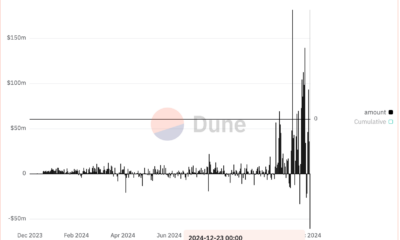Crypto scam
Are users paying for the exchange’s failures?
Published
5 months agoon
By
admin

Is WazirX prioritizing its own survival over user security with the “socialized loss strategy,” and how does this impact the Indian crypto community?
On July 18, WazirX, India’s largest crypto exchange, faced a severe cyber attack. Hackers targeted one of their multisig wallets and made off with over $230 million worth of digital assets.
The attack saw the direct theft of 15,298 Ethereum (ETH), with the exploiter then swapping various tokens like Shiba Inu (SHIB), Polygon (MATIC), and Pepe Coin (PEPE) to gather a total of 59,097 ETH, impacting WazirX’s ability to maintain a 1:1 collateral with its assets.
Adding fuel to the fire, WazirX halted all trading activities as the prices on their platform crashed to levels far below those on other exchanges. Furthermore, WazirX has also frozen all withdrawals, both in crypto and INR, leaving customers unable to access their funds.
Given the scale of this incident, which affected 45% of user funds, the exchange’s trustworthiness, once boasted to over 15 million users, is now in serious doubt. To address this crisis, WazirX has proposed a controversial recovery plan.
On July 27, they announced a “socialized loss strategy,” aiming to distribute the losses among users to maintain platform stability. Under this plan, users will have immediate access to only 55% of their assets, while the remaining 45% will be locked in Tether-equivalent tokens.
This move, intended to prevent disproportionate impacts on any single group, has stirred stark backlash across social media. Many users feel betrayed by what they perceive as a blatant disregard for their assets’ security and integrity.
Let’s dive into the details and understand the public’s reaction to this contentious strategy.
Pick your poison, but you can’t cash out
WazirX’s controversial recovery plan, branded as the “socialized loss strategy,” has sparked heated debate among its users.
According to correspondence shared with affected users, the exchange presented a poll offering two options to recover their stolen funds.
“Option A” permits users to access 55% of their funds “for trading and deposits” but restricts withdrawals. This option also gives users priority in potential recovery proceeds.
On the other hand, “Option B” allows users to withdraw 55% of their assets “in a staggered manner,” but with a lower priority in the recovery queue.
In both scenarios, WazirX states that the remaining 45% of user assets will remain locked on the exchange as “USDT-equivalent tokens,” which would only be returned if the firm successfully recovers the stolen funds.
The value of the unlocked portfolio (55%) will be calculated based on average prices from CoinMarketCap and select global exchanges as of July 21, 2024, 8:30 PM IST.
Registered users received an email with detailed instructions and a link to select their preferred option. The deadline for responses is August 3, 2024, at 07:00 AM IST.
However, this poll is not legally binding upon the users or WazirX. The final decision will be made after considering the poll results, ongoing investigations, the platform’s liquidity, and any evolving circumstances, the platform announced on July 29.
Dear WazirX Tribe,
We appreciate your active participation in our recent poll from 27 July 2024. We want to clarify that this poll is a preliminary step to understand your opinions and is not legally binding upon the users or the WazirX platform.
We reassure you that this poll… pic.twitter.com/8BkbjhTCjM
— WazirX: India Ka Bitcoin Exchange (@WazirXIndia) July 29, 2024
This plan has led to widespread outrage and skepticism. Many users perceive this strategy as a way for WazirX to avoid full responsibility for the losses.
Moreover, the restriction on withdrawals, coupled with the non-binding nature of the poll, leaves users feeling that their assets are still at critical risk.
WazirX’s recovery plan faces fierce backlash
The public backlash against WazirX’s controversial recovery plan has been swift and severe.
Sumit Gupta, the co-founder and CEO of CoinDCX, was among the first prominent figures to criticize the exchange’s handling of the situation.
He mentioned on X that the burden of losses should primarily fall on WazirX itself, using its own treasury and assets, rather than making customers bear a 45% loss.
Hate to be saying this, but the way @WazirXIndia is handling this entire situation isn’t community first and this IMO won’t go down well for them. This sadly is also hurting the other ecosystem participants.
The first contribution to losses should ALWAYS come from the Company…
— Sumit Gupta (CoinDCX) (@smtgpt) July 29, 2024
Gupta also pointed out that the poll options were framed to protect the business rather than its customers, calling the approach “utter nonsense.”
Brian Kuttikat, COO of KoinBX, expressed a similar sentiment in an exclusive conversation with crypto.news, citing WazirX’s strategy of “socializing losses” as highly controversial.
He acknowledged the intentions behind the approach but questioned its effectiveness in offsetting the losses faced by affected users.
Meanwhile, the call for justice has grown louder, with many users demanding strict intervention and criminal proceedings against WazirX and its head, Nischal Shetty.
One user shared a letter addressed to a DCP officer, insisting on a CBI inquiry to determine whether the incident was a hack or an insider job.
CBI inquiry is imperative to determine whether this #Wazirx incident was a hack or an insider job. If it turns out to be a hack, I may offer my support in the future. However, uncovering the truth is my priority. and I am committed to pursuing justice relentlessly, even if
1/2 pic.twitter.com/Qmh2GmNJym
— Justice for WazirX Users (@IndiasCrypto) July 28, 2024
Further critiques of WazirX’s approach poured in from various quarters.
Kashif Raza, another vocal critic, outlined several flaws in the proposed solution. Raza argued that the snapshot for asset valuation should have been taken before the hack, criticized the allocation and profit usage of WRX tokens, and questioned the fairness of penalizing users with non-stolen tokens.
WazirX Solution is Not Acceptable?
1) The snapshot should have been taken on or before 18th July 2024.
2) WRX foundations were allocated 30% of WRX tokens. The team and Foundation made some money on WRX tokens that can be paid off.
3) Why should the users with Non-Stolen… pic.twitter.com/fW5JkC7NO9
— Kashif Raza (@simplykashif) July 29, 2024
Raza also raised concerns about tax liabilities on top of user losses and demanded transparency regarding WazirX’s financials and profit usage to compensate victims.
The overarching sentiment is one of betrayal and frustration, with many questioning the fairness, legality, and transparency of the recovery plan.
In the face of this backlash, Nischal Shetty, the head of WazirX, mentioned that the poll presented to users was a preliminary step to understand their opinions and is not legally binding.
1. This poll is a preliminary step to understand your opinions.
2. This poll is not legally binding upon the users or WazirX
3. We will soon launch feedback form to collect more ideas
4. We are now looking into next steps based on all the feedback receivedThis is a major… https://t.co/tcdDjWzIYI
— Nischal (Shardeum) 🔼 (@NischalShetty) July 29, 2024
Shetty assured users that a feedback form would soon be launched to gather more ideas and that the team is considering all the feedback received to determine the next steps.
Take the taxes and stay quiet
India has emerged as a global leader in crypto adoption, topping Chainalysis’s Global Crypto Adoption Index in September 2023. However, this enthusiasm appears to be one-sided, with the government and regulators maintaining a conspicuous silence on the subject.
In the 2022 budget, the government introduced stringent income tax rules for crypto transfers, taxing any income earned from these transactions at a hefty 30%. No deductions are allowed, except for the cost of acquisition, and losses cannot be offset against other income or carried forward to future years.
The irony is palpable: while the government is quick to tax crypto gains, it offers no safety net when things go awry.
Meanwhile, the Reserve Bank of India (RBI) has also been silent, with the last notable statement coming from Deputy Governor Shri T. Rabi Sankar in February 2022.
In his speech, he mentioned crypto’s risks to the financial system, comparing them to speculative assets with no intrinsic value. He warned of the destabilizing effects they could have on monetary policy and financial stability.
This approach has created a precarious environment for investors. On one hand, they face high taxes and strict regulations; on the other, they receive no support or protection from the government during crises, such as the ongoing WazirX fiasco.
At this point, both WazirX and the government seem to have prioritized their own interests over those of individual investors. The lack of transparency and support from both parties has left investors feeling abandoned and betrayed.
As India continues to lead in crypto adoption, it is imperative for the government to engage more actively and constructively with the industry. Ignoring the issue is not a viable long-term strategy.
Source link
You may like


Most Layer 2 solutions are still struggling with scalability


Here’s why Stellar Price Could Go Parabolic Soon


Perp-Focused HyperLiquid Experiences Record $60M in USDC Net Outflows


Experts say these 3 altcoins will rally 3,000% soon, and XRP isn’t one of them


Robert Kiyosaki Hints At Economic Depression Ahead, What It Means For BTC?


BNB Steadies Above Support: Will Bullish Momentum Return?
Blockchain
Crypto fakes on X nearly doubled, reaching over 300 accounts daily
Published
2 weeks agoon
December 10, 2024By
admin

Bad actors keep ramping up crypto scams, with impersonation accounts surging to over 300 a day, according to blockchain analysts.
Crypto scams on X are once again rising fast, with major accounts hijacked to promote fake tokens. Victims have already lost millions, and experts are warning users to stay alert.
Analysts at blockchain firm Scam Sniffer warned in an X post on Dec. 10 that starting this week, daily impersonation accounts surged by 87%, jumping to over 300 compared to the November average of 160. The spike increases the risk for users as scammers continue to exploit high-profile accounts to push fraudulent schemes.
🚨 SCAM ALERT: Surge in X Impersonations 📈
Our monitoring system detected a significant increase in crypto fake accounts this week, with daily numbers reaching 300+ (vs. Nov avg. 160) 📊
⚠️ Two victims lost over $3M recently from clicking malicious links/signing transactions… pic.twitter.com/eGhG1GPX0r
— Scam Sniffer | Web3 Anti-Scam (@realScamSniffer) December 10, 2024
The analysts note that in one recent case alone, two victims lost over $3 million worth of crypto by interacting with malicious links and signing transactions linked to fake accounts. As crypto.news reported earlier, the scams are particularly prevalent on Solana (SOL), where compromised accounts, including those of major entities like Yahoo News UK, Lenovo India, and Money Control, have been used to push a scam meme coin called HACKED.
Blockchain sleuth ZachXBT, who has been tracking these scams, recently issued a warning to the crypto community, advising users to be extra cautious. “So far, it seems the scammers may have lost money, as the market cap of the HACKED token is a modest $67K, and top traders have barely made $1K,” ZachXBT noted.
The compromised X accounts appear to have been connected to the same malicious site or application. As a precaution, ZachXBT recommends that users revoke any access permissions to unfamiliar sites or apps.
The latest incident follows a series of similar scams, including the recent use of Kylian Mbappé’s account to promote a fake MBAPPE meme coin. Earlier in September, hackers also targeted family members of U.S. president-elect Donald Trump in a scam involving the fake World Liberty Financial coin.
Source link
Crypto scam
Why HAWK Memecoin Crashed from $500M to $60M in Minutes
Published
3 weeks agoon
December 5, 2024By
admin

Hailey Welch, an influencer on social media, launched her own memecoin, Hawk Tuah, on Dec. 4. The cryptocurrency crashed from $500 million to $60 million in just 20 minutes post-launch.
Hailey Welch, commonly known as the Hawk Tuah Girl on the internet, launched her new memecoin of the same name, $HAWK, on Solana on Dec. 4. The coin quickly took off, garnering a market cap of about $500 million, which then crashed to nearly $60 million, all within 20 minutes of launch. The news was further confirmed by Solana (SOL) on X.
Who is Hawk tuah girl?
Welch first rose to fame as the “Hawk tuah girl” after a video of her went viral, making a comical onomatopoeic sound of spitting took over social media earlier this year. With the meme, Welch soon progressed from working a minimum wage job to finding herself in an internet meme culture. Building on this viral moment, Welch launched the HAWK token.
Rise and fall of HAWK token
The massive drop of almost 88% in the HAWK token has reignited the discussion on the high volatility of memecoins in the cryptocurrency community. Some crypto users believe the token was initially built for rug pulling, a cryptocurrency scam in which developers withdraw liquidity or suddenly abandon a project, resulting in the token’s price plummeting.
According to content generated by the community on X, the Hawk token’s supply was allegedly “sniped” shortly after launch. This refers to instances where early investors or bots snatch up large amounts of tokens, leaving the broader community with less access and exposing them to risks. These are often warning signs of the health of the project as it shows few people own the token. However, not all holders have sold their HAWKs, as posted by a user, ZeusLFG, reflecting a strong optimism for the token.
At the time of writing, the token’s trading volume has risen exponentially by 951.67%, as per CoinMarketCap. While the debate goes on, Hawk Token remains under close observation, with members of the community demanding additional disclosures to confirm these claims and keep a close eye on this project.
Source link
24/7 Cryptocurrency News
Pro Gamer Linked to $3.5M Meme Coin Scam: ZachXBT
Published
4 weeks agoon
November 28, 2024By
admin
The crypto market has become the center of attention, with the Bitcoin price aiming at the $100k mark. However, another incident is also gaining investors’ attention these days. A famous crypto investigator, ZachXBT made a major crypto scam finding, linking a pro gamer to a $3.5M meme coin scam. More importantly, these scams were also linked to major celebrity social media account hacks, scam promotions, and much more.
At one point, the crypto industry had earned a name for itself among the biggest finance entities, with $3.31T in global market capitalization. However, the rising crypto scams, theft, and laundering are concerning. Even Changpeng Zhao showed disappointment in memecoin and the rising scams.
ZachXBT Unveils $3.5M MemeCoin Scam and the Culprit
In 2024, the crypto market faced many wallet hacks, rug pull scams, and many other concerning scams. However, celebrity account hacks and the promotion of cryptocurrency-related scams were the most frequent.
Considering the rising case, a popular crypto investigator, ZachXBT, analyzed nine celebrity account hacks and the involved meme coins. He concluded that there is a connection between all these hacks. More importantly, he claimed that a pro-Fortnite gamer known by the name Serpent is the mastermind behind this.
ZachXBT linked this pro gamer in the $3.5M meme coin scam, confirming that he used multiple Pump.Fun memecoin and pump and dump tactics to make millions. Surprisingly, the biggest connection was the Serpent’s ERROR project wallet, which interacted with every social media hacker’s wallets directly or indirectly.
1/ An investigation into how the threat actor Serpent went from a pro Fortnite player to helping steal $3.5M via meme coin scams launched from 9+ account compromises on X & IG and gambling the proceeds away at online casinos. https://t.co/zR6QtuQW8a pic.twitter.com/Y8ovnEnQgj
— ZachXBT (@zachxbt) November 27, 2024
Serpent is known as a pro gamer and blockchain security analyst. He is even the founder of the Sentinel, which is a threat mitigation system but new reports link him with the scam, making it a big controversy. More importantly, he scammed $3.5M and gambled them away in online casinos. The controversy grew as Serpent deleted many of his X posts right after ZachXBT’s claims.
Breaking Down The Serpent’s Crypto Scam
In a detailed X post, ZachXBT revealed his finding to the crypto community, which explained the memecoin scams of more than $3.5M after the scammer compromised various celebrity social media accounts. It includes the account hacks of McDonald’s, Usher, Kabosu Owner, Andy Ayrey, Wiz Khalifa, SPX 6900, etc X (Twitter) and Instagram.


McDonald’s Instagram hack was among the first hacks of the year, where the scammer promoted a memecoin called GRIMACE and earned more than $690k with the pump and dump tactics. This happened on August 21, and the person shifted the funds to two main crypto wallets. The crypto scammer transferred 101.5 SOL to two addresses on September 3 and deployed the SCHRADER token. Interestingly, this token was promoted during the Actor Dean Norris X account hack.
Further, on September 6, the scammer processed Mcdonald’s ATO to a casino deposit address with the beginning address as B2fw. This same account transferred 110 Sol to two new wallet addresses on September 12 and sniped the meme coins which was used during the Usher crypto hack. The same B2fw wallet transferred 4868 SOL to casino deposit address ECb5v, which is connected to Andy Ayrey and the Enoshima Aquarium hack on October 15. Within the same day, 84 SOLs were transferred to ECb5v.
Even the popular AI bot Truth Terminal owner’s X account got hacked on October 29, which stayed compromised for days. In that period, 6 memecoins were promoted on his account. All these involved a common 3GVUs wallet, and the same wallet transferred 169 SOL to Ecb5vs on October 30. However, this is just the mid, the list goes on for others.
Bottom Line
Meme-themed cryptocurrencies gained investors attention in 2024, where many offered heavy gains, mainly the Solana memecoins. As a result, millions of Solana-based meme tokens were launched this year on Pump. Fun, but many were misused for crypto scams. With his recent investigation, ZachXBT has revealed the person behind the $3.5M meme coins scam. The scams also involved hacking celebrity accounts and promoting tokens to boost their price and dumping them all. This way, the scammer or alleged pro-Fortnite gamer Serpent made heavy returns, but others were left with losses.
Pooja Khardia
With a deep-seated passion for reading and five years of experience in content writing, Pooja is now focused on crafting trending content about cryptocurrency market.
As a dedicated crypto journalist, Pooja is constantly seeking out trending topics and informative statistics to create compelling pieces for crypto enthusiasts. Staying abreast of the latest trends and advancements in the field is an integral part of her daily routine, fueling a commitment to delivering timely and insightful coverage
Disclaimer: The presented content may include the personal opinion of the author and is subject to market condition. Do your market research before investing in cryptocurrencies. The author or the publication does not hold any responsibility for your personal financial loss.
Source link

Most Layer 2 solutions are still struggling with scalability

Here’s why Stellar Price Could Go Parabolic Soon

Perp-Focused HyperLiquid Experiences Record $60M in USDC Net Outflows

Experts say these 3 altcoins will rally 3,000% soon, and XRP isn’t one of them

Robert Kiyosaki Hints At Economic Depression Ahead, What It Means For BTC?

BNB Steadies Above Support: Will Bullish Momentum Return?

Metaplanet makes largest Bitcoin bet, acquires nearly 620 BTC

Tron’s Justin Sun Offloads 50% ETH Holdings, Ethereum Price Crash Imminent?

Investors bet on this $0.0013 token destined to leave Cardano and Shiba Inu behind

End of Altcoin Season? Glassnode Co-Founders Warn Alts in Danger of Lagging Behind After Last Week’s Correction

Can Pi Network Price Triple Before 2024 Ends?

XRP’s $5, $10 goals are trending, but this altcoin with 7,400% potential takes the spotlight

CryptoQuant Hails Binance Reserve Amid High Leverage Trading

Trump Picks Bo Hines to Lead Presidential Crypto Council

The introduction of Hydra could see Cardano surpass Ethereum with 100,000 TPS
182267361726451435

Why Did Trump Change His Mind on Bitcoin?

Top Crypto News Headlines of The Week

New U.S. president must bring clarity to crypto regulation, analyst says

Will XRP Price Defend $0.5 Support If SEC Decides to Appeal?

Bitcoin Open-Source Development Takes The Stage In Nashville

Ethereum, Solana touch key levels as Bitcoin spikes

Bitcoin 20% Surge In 3 Weeks Teases Record-Breaking Potential

Ethereum Crash A Buying Opportunity? This Whale Thinks So

Shiba Inu Price Slips 4% as 3500% Burn Rate Surge Fails to Halt Correction

Washington financial watchdog warns of scam involving fake crypto ‘professors’

‘Hamster Kombat’ Airdrop Delayed as Pre-Market Trading for Telegram Game Expands

Citigroup Executive Steps Down To Explore Crypto
Mostbet Güvenilir Mi – Casino Bonus 2024

NoOnes Bitcoin Philosophy: Everyone Eats
Trending

 3 months ago
3 months ago182267361726451435

 Donald Trump5 months ago
Donald Trump5 months agoWhy Did Trump Change His Mind on Bitcoin?

 24/7 Cryptocurrency News4 months ago
24/7 Cryptocurrency News4 months agoTop Crypto News Headlines of The Week

 News4 months ago
News4 months agoNew U.S. president must bring clarity to crypto regulation, analyst says

 Price analysis4 months ago
Price analysis4 months agoWill XRP Price Defend $0.5 Support If SEC Decides to Appeal?

 Opinion5 months ago
Opinion5 months agoBitcoin Open-Source Development Takes The Stage In Nashville

 Bitcoin5 months ago
Bitcoin5 months agoEthereum, Solana touch key levels as Bitcoin spikes

 Bitcoin5 months ago
Bitcoin5 months agoBitcoin 20% Surge In 3 Weeks Teases Record-Breaking Potential



✓ Share: